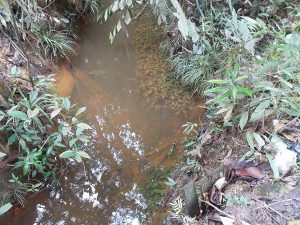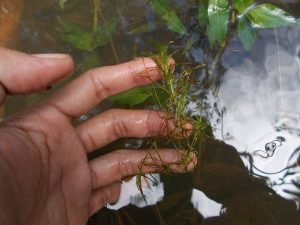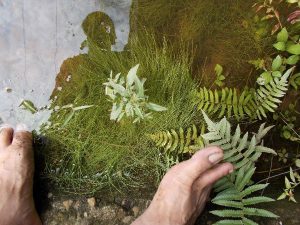 Outfitted with a few plastic bags and a camera Slamet sets off to hunt for and collect new plants for his displays. Cryptocorynes along the roadside are a commonly found but desirable aquarium plant suitable to be grown emersed above water, or submerged in the aquarium. It isn’t terribly uncommon to find new but slight variations in long known species of cryptocoryne along the roadside streams.
Outfitted with a few plastic bags and a camera Slamet sets off to hunt for and collect new plants for his displays. Cryptocorynes along the roadside are a commonly found but desirable aquarium plant suitable to be grown emersed above water, or submerged in the aquarium. It isn’t terribly uncommon to find new but slight variations in long known species of cryptocoryne along the roadside streams.
This photo captured on the trip shows the habitat that some plants can adapt to and thrive. Unfortunately, not all plants adapt as well as these particular species can to roadside conditions.
 Photos that document these kinds of growing conditions can help us learn what plants can grow together in our wabi kusa, biotopes, and other planted displays. It also is a great window into creating a suitable substrate when necessary as well. Water conditions can also give a hint into conditions to recreate when building biotope displays even when we cannot have exact data from the location.
Photos that document these kinds of growing conditions can help us learn what plants can grow together in our wabi kusa, biotopes, and other planted displays. It also is a great window into creating a suitable substrate when necessary as well. Water conditions can also give a hint into conditions to recreate when building biotope displays even when we cannot have exact data from the location.
Areas that are interesting but not commonly thought about are how natural water levels fluctuate. This goes to prove that not all our aquarium plants are completely aquatic, and that all terrestrial plants die when overwatered.
Most plants have a window of conditions that they can grow and survive in. Thriving conditions are usually more narrowly defined but these terrestrial ferns have been temporarily flooded and will survive easily.
 While the rule of thirds isn’t apparent in this natural stand of suitable plants for a display, it gives us inspiration if we look. We can see that several species of plants are living together and can complement each other. Various heights and foliage types pair well together and make a natural looking display when planted together. These plants are growing together naturally and we can tell that they have the same growing requirements.
While the rule of thirds isn’t apparent in this natural stand of suitable plants for a display, it gives us inspiration if we look. We can see that several species of plants are living together and can complement each other. Various heights and foliage types pair well together and make a natural looking display when planted together. These plants are growing together naturally and we can tell that they have the same growing requirements.
Various heights and foliage types pair well together and can make a natural looking display when planted together. These plants are growing together naturally and we can tell that they have the same growing requirements.
This combination of plant textures and sizes would make a great wabi kusa or biotope display. We can learn a lot from looking at a few pictures. Inspiration often comes from places we think the least to look, or don’t have access to. A few impromptu photographs can speak volumes to our designs to further our enjoyment and experience.
 Biotope One A Study of Flora and Fauna
Biotope One A Study of Flora and Fauna 


